Greetings from Farmer Tom
~~~~~~~~~~~~~~~~~~~~~~~~~~~~~~~~~~~~~~~~~~~~~~~~
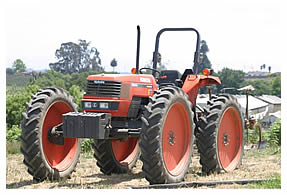 As you know from gardening, using the right tools can make all the difference
in how well we care for and manage the soil into which we plant. The heaviest
and physically most demanding job on the farm is tilling, which is the general
term for soil preparation. It includes working the soil, incorporating soil amendments
such as lime, gypsum, rock dust, compost, green manures (cover crops), and other
mechanical processes. Today, we could not accomplish these tasks without the
help of our tractors – the mechanical substitutes for traditional draft
animals. We have different tractors for different tasks; the larger and more
powerful ones are generally used for primary cultivation, which includes deep
tillage. Deep tillage involves pulling 2-3 foot long shanks of steel through
the ground to aerate the soil. As you know from gardening, using the right tools can make all the difference
in how well we care for and manage the soil into which we plant. The heaviest
and physically most demanding job on the farm is tilling, which is the general
term for soil preparation. It includes working the soil, incorporating soil amendments
such as lime, gypsum, rock dust, compost, green manures (cover crops), and other
mechanical processes. Today, we could not accomplish these tasks without the
help of our tractors – the mechanical substitutes for traditional draft
animals. We have different tractors for different tasks; the larger and more
powerful ones are generally used for primary cultivation, which includes deep
tillage. Deep tillage involves pulling 2-3 foot long shanks of steel through
the ground to aerate the soil. 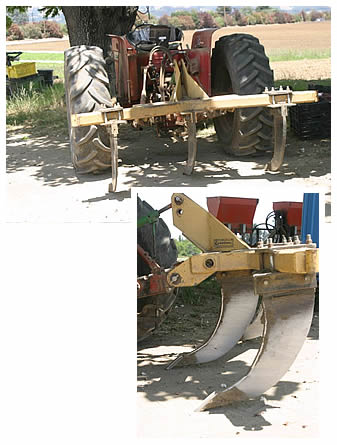 Deep tillage is important to break up compacted
layers without mixing the subsoil with the topsoil. It improves drainage, rooting
depth, and the amount of soil nutrients for the roots, helping the process of
topsoil deepening, which greatly increases the fertility of the soil. Then there’s
surface tillage. For surface tillage we use a disc or spader, which only disturbs
the top 4-6 inches of soil, and is ideal to achieve the right tilth for planting
and sowing. Deep tillage is important to break up compacted
layers without mixing the subsoil with the topsoil. It improves drainage, rooting
depth, and the amount of soil nutrients for the roots, helping the process of
topsoil deepening, which greatly increases the fertility of the soil. Then there’s
surface tillage. For surface tillage we use a disc or spader, which only disturbs
the top 4-6 inches of soil, and is ideal to achieve the right tilth for planting
and sowing.
The real art of driving a tractor is in cultivating and weeding between rows
of crops that are already established in the field. Here, different knives, shovels
and discs are set up in such a way that they cut, remove and throw soil all at
the same time, just inches away from the crop that is growing. If the timing
is right regarding the moisture and development stage of both crop and weeds,
we can cultivate everything mechanically with the tractor and avoid the more
time consuming and arduous task of hoeing and weeding by hand. Most of the time
we achieve the best results through a combination of hand and mechanical cultivation.
When you receive your share of vegetables every week, I want you to think for
a moment, not just of the farm or the farmer, but about the soil. 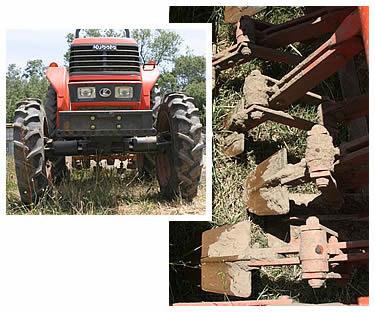 It is truly
THE fundamental substance and source of life on Earth, and we, like all other
terrestrial life forms, depend on soil directly or indirectly for our food. As
a farmer, I see the importance of growing good, healthy soil as my most important
task. The healthier the soil, the healthier and more nutritious the crops you
receive will be. To understand this link between our existence and the quality
of the soil is to understand the fundamental interconnectedness of all things.
As a farmer, I constantly think of ways to coax a harvest from the soil: when
to plow, which crops to plant and rotate, how to protect the soil from the weather
so that the forces which put it together cannot take it apart. I strive to fit
my needs into the natural systems, which have adapted to the local conditions
designed by this place over a long period of time. With every group that visits
the farm, I make it a habit to have everyone touch and feel the soil we stand
on, to bring their attention to the fundamental substance and source of our nourishment. It is truly
THE fundamental substance and source of life on Earth, and we, like all other
terrestrial life forms, depend on soil directly or indirectly for our food. As
a farmer, I see the importance of growing good, healthy soil as my most important
task. The healthier the soil, the healthier and more nutritious the crops you
receive will be. To understand this link between our existence and the quality
of the soil is to understand the fundamental interconnectedness of all things.
As a farmer, I constantly think of ways to coax a harvest from the soil: when
to plow, which crops to plant and rotate, how to protect the soil from the weather
so that the forces which put it together cannot take it apart. I strive to fit
my needs into the natural systems, which have adapted to the local conditions
designed by this place over a long period of time. With every group that visits
the farm, I make it a habit to have everyone touch and feel the soil we stand
on, to bring their attention to the fundamental substance and source of our nourishment.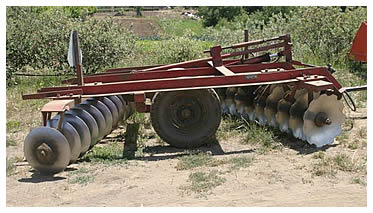
Slowly but steadily we are adopting a new consciousness, one based more on agrarian
principles. By agrarian, I mean a mind-set of respecting our interconnectedness
with the rest of nature, and honoring ways that sustain and perpetuate the commonwealth.
You don’t have to get dirt under your fingernails or spend a day pulling
weeds, or grow vegetables in your apartment or keep the family cow in your garage.
But being more aware of where your food comes from, and of the amount of work
that goes into producing it is a start.
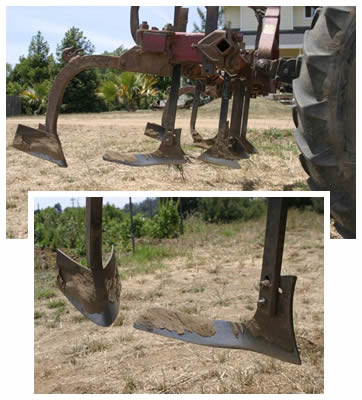 If,
however, you want to take another step down that path of agrarian awareness,
I am going to open the door again to the idea of Farm Work Days. So before making
a life-changing decision to quit your desk job to start farming, consider instead
swapping a day of working behind a desk (or whatever you do) for a day of working
in the field. We have already started a process like this with the local Montessori
Middle School (see next story), but due to persistent inquiries by members for
the opportunity to help out on the farm, we are going to set up Work Days for
this purpose (see Farm Work Days, below). If,
however, you want to take another step down that path of agrarian awareness,
I am going to open the door again to the idea of Farm Work Days. So before making
a life-changing decision to quit your desk job to start farming, consider instead
swapping a day of working behind a desk (or whatever you do) for a day of working
in the field. We have already started a process like this with the local Montessori
Middle School (see next story), but due to persistent inquiries by members for
the opportunity to help out on the farm, we are going to set up Work Days for
this purpose (see Farm Work Days, below).
- Tom
Here is a field of green beans that has just been cultivated:
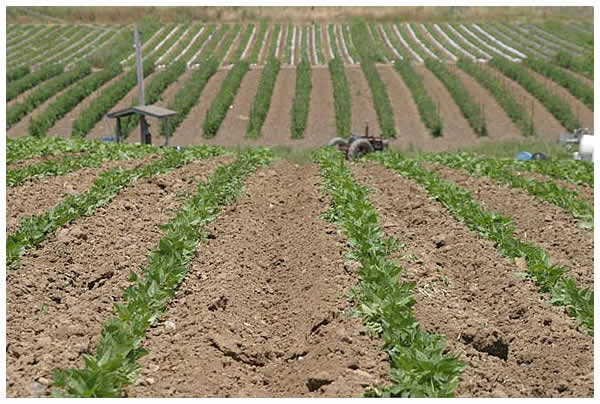
<back to top>
|
Future Farmers?
~~~~~~~~~~~~~~~~~~~~~~~~~~~~~~~~~~~~~~~~~~~~~~~~
Approximately 40 Middle School students from the Santa Cruz Montessori came to
work on the farm last Tuesday and Wednesday. I enjoyed the diverse levels of
enthusiasm and energy expressed by the group, and was astonished how much we
were able to get done in such a short period of time. The entire group descended
on the radish patch and harvested 300 bunches for Wednesday's shares, then picked
more than 10 flats of strawberries (which were turned into delicious smoothies
the next day). They pulled onions and laid them out to dry, planted sunflowers
and gourds, and even helped assemble share boxes for Thursday's delivery. We
are exploring the idea of integrating the farm into the Montessori Middle School
curriculum. This idea would directly follow Maria Montessori's vision: she believed
that farm life greatly benefits the development of adolescent children by putting
them in direct contact with the land and engaging them in on-farm activities,
which in turn serve as the basis for pursuing science, environmental, social
and economic studies.
<back to top>
|
Farm Work Days!
~~~~~~~~~~~~~~~~~~~~~~~~~~~~~~~~~~~~~~~~~~~~~~~~
Get more involved with your farm – spend a day on the land, helping out
with any number of farm tasks. Like your CSA box (where you don’t select
its contents), you won’t pick the task, but rather it will be whatever
needs doing on the farm on the day you arrive. Experience the joy and satisfaction
of working in tandem and community with other members to get a job done, and
enjoy a day outdoors. We need a minimum of 5 people to hold a Work Day, but could
easily accommodate up to 40, so don’t be shy!
Specifics:
<> Work Days will be held on the last Friday of each month, starting now
(June) and going through October [Dates: 6/29, 7/27, 8/31, 9/28, 10/26]. You
can come just one time, or every month!
<> As this would be a true workday, we would need you to arrive no later
than 9am (shoot for 8:45 to be safe!). If you’ve never been here before,
directions to the farm are on our website. Want to carpool? Try posting a note
on the Friends of LEF Yahoo
Group!
<> We will work about 3 hours, then break for lunch, then work approximately
another 3 hours after lunch, then quit for the day.
<> Pack yourself a lunch (we can keep it in the cooler for you), and bring
water, hat, gloves, sunscreen, and shoes that can get dirty. We will provide
any tools, if needed.
<> We need to know you are coming. Call or email Debbie at the farm to
get on the schedule for whatever date(s) you would like to work. We will announce
in that week’s newsletter if a Work Day is ‘on’ (i.e. we have
enough participation).
<back to top>
|
Pictures around the farm
~~~~~~~~~~~~~~~~~~~~~~~~~~~~~~~~~~~~~~~~~~~~~~~~
First: a quick soil primer – top: our former fava bean field, showing
the organic matter which has been worked back into the soil. Middle:
a pile of compost, and bottom, a neighbor's field. Note how our soil
is dark and rich from the built up organic matter (compare it to the
color of the compost).
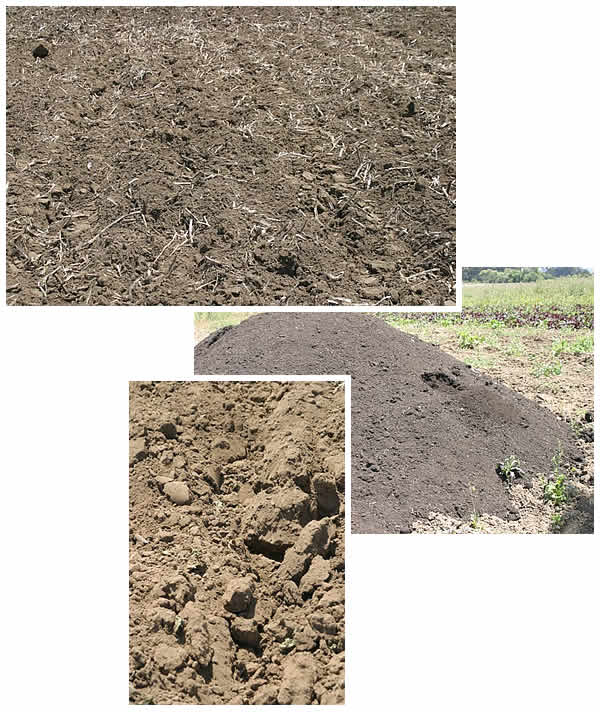
The field of Dinosaur Kale, from which will be harvested the kale in
your shares this week!
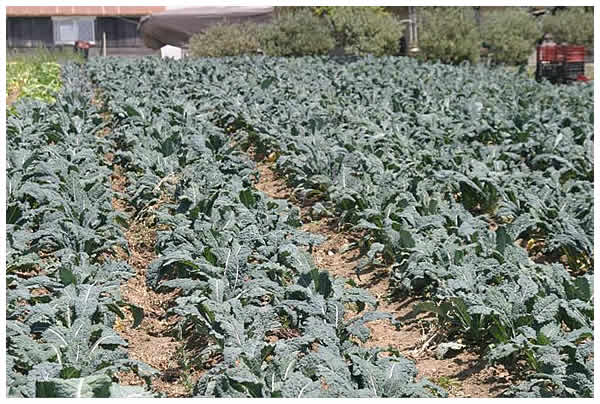
Ditto for the beets.
At left, the Bulls Blood beets (note the dark red leaves). At right, the
Italian Forono beets, with lovely green foliage and long, tapered roots.
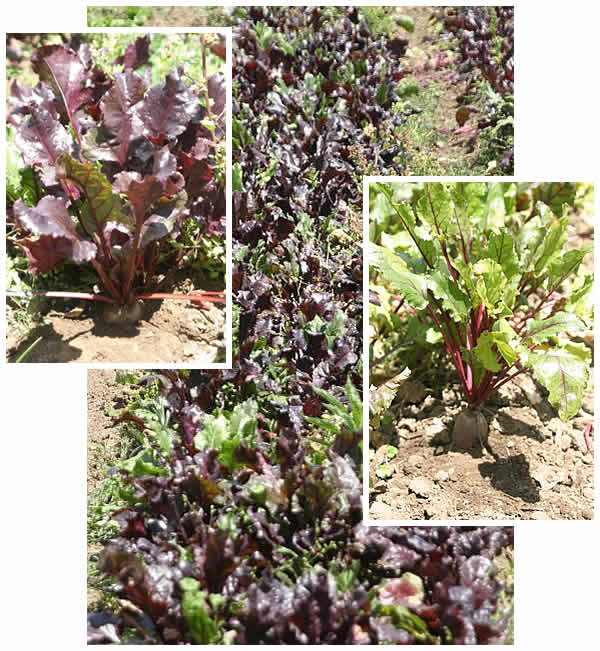
Here is the yellow Zephyr squash on the vine. Note the honeybee and squash
beetle, sharing the same blossom!
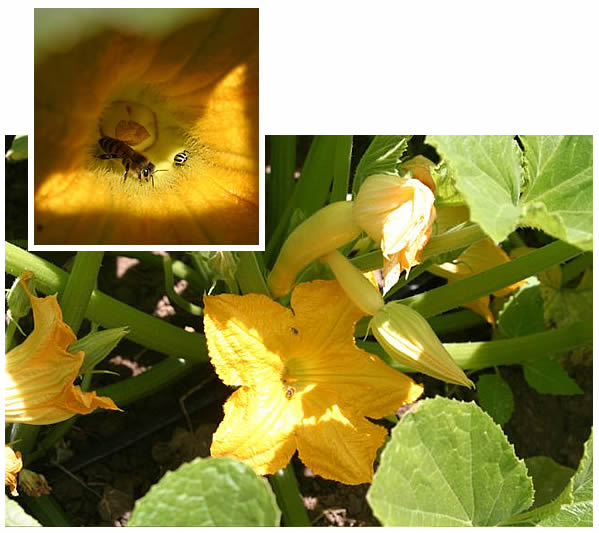
The Warren pears are sizing up!!!
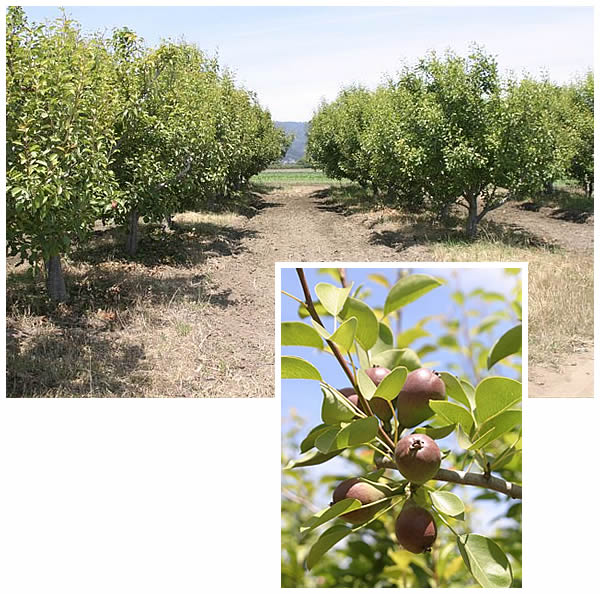
For our "Extra Fruit" option members, a peek at what's imminent - red and
golden raspberries!

And for everyone... see the almost-ready green bean, at right, and the
tomatoes, small, but getting bigger!
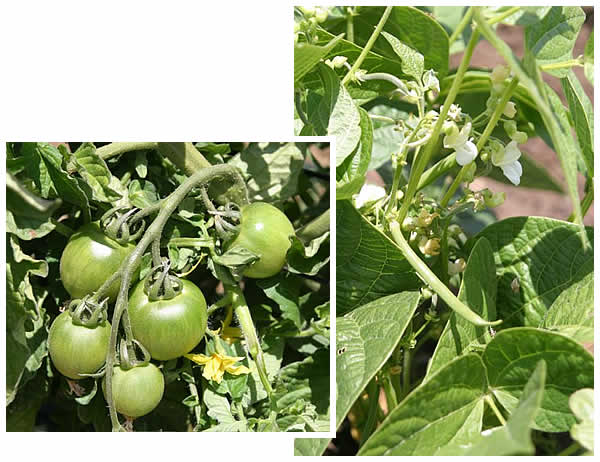
Lastly, a beautiful Pineapple Guava blossom. This is a late season fruit,
so we won't see them in the shares until October or so.
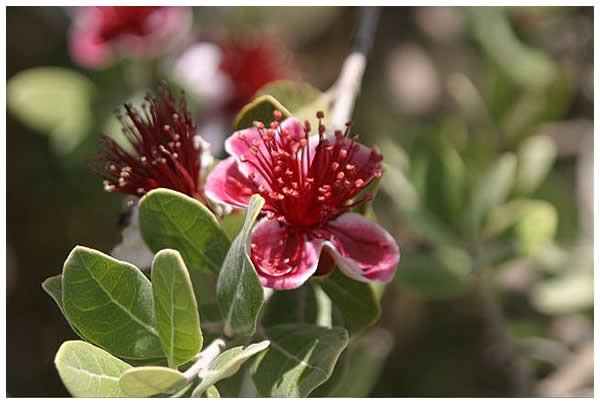
<back to top>
|
What's in the box this week
~~~~~~~~~~~~~~~~~~~~~~~~~~~~~~~~~~~~~~~~~~~~~~~~
(Content differences between Family and Small
Shares are underlined and italicized; items with a “+” in
Family Shares are more in quantity than in Small; anticipated quantities are
in parentheses. Sometimes the content of your share will differ from what's on
this list, but we do our best to give you an accurate projection. It's Mother
Nature that throws us the occasional curve ball!)
Family Share:
Arugula
Beets
Broccoli (LEF/Lakeside)
Chinese (Napa) cabbage
Fennel
Garlic
Dinosaur kale
Lettuce +
Mei qing choi (3)
Mizuna
Onions
Radishes
Strawberries (2 baskets)
Small Share:
Arugula
Broccoli (LEF/Lakeside)
Carrots
Garlic
Dinosaur kale
Lettuce
Mizuna
Radishes
Summer Squash
Strawberries (2 baskets)
***Upcoming in 2 weeks in both Family and Small Shares: potatoes and green beans!***
Extra Fruit Option:
4 baskets of strawberries
[Blackberries or Raspberries start next week!!!]
"Strawberry Bounty" Option:
5 baskets of strawberries!
<back to top>
|
Notes from Debbie's Kitchen
~~~~~~~~~~~~~~~~~~~~~~~~~~~~~~~~~~~~~~~~~~~~~~~~
(Click
here to go to my extensive
recipe database, spanning nearly 10 years of CSA recipes and alphabetized
by key ingredient. Includes photos of most farm veggies; helpful for
ID-ing things in your box!)
What to do with this week’s box
I have so many
recipes in the database, I often go there for inspiration myself. So here are
a good selection of recipes and ideas from the database for using what’s
in the box this week (interspersed with new ideas!). Some of them are little
hidden gems, like this first one for radishes, buried in the “Arugula
Salad with Pecorino Romano and Toasted Walnuts” recipe.
Member Sue Burnham points out how great the dressing for this salad is on sliced
radishes! So if you will, think of it as a recipe for ‘Radishes in walnut
oil vinaigrette.’ A recipe I’ve made and really liked is the “Pasta
with Golden Fennel”, in which the fennel is cooked down and caramelized,
like onions. This would be great atop homemade pizza too! For beets, I’d
definitely try Farrell Podgorsek’s Beet Salad with Pomegranate Dressing
(see recipe, below). Mizuna... I don’t have a lot of recipes for
that yet, but really, here’s what I’d do: if the leaves are small
and tender, I’d use them with lettuce and arugula in a salad. If they’re
larger and more mature, I’d sauté them up in a little olive oil
with some garlic or onion (or both!), and splash on a little vinegar and a bit
of salt. If you’re an omnivore, they’d be good paired with meat of
some sort. Dice up some ham or bacon and include in the sauté, or sauté the
greens and serve with meat, fish or poultry. Broccoli? I’m sure
you all have your own ways to use it, so I’ll skip along to the Mei
qing choi [I
just learned last week that there is no ‘u’ in ‘qing’ – first
time I’ve ever seen a word with a ‘q’ in it that wasn’t
paired with a ‘u’]. Try the Bok
Choi in Oyster Sauce (Mei qing choi
can be used interchangeably in any bok choi recipe). Summer squash...
try this one (an old favorite!): “Sautéed
Fennel & Zucchini.” It’s
easy to make and really tasty. And if you have that fresh oregano out your back
door in your herb garden... here’s your chance to use it! And the kale...
oh, gosh – there are so many good recipes for kale in the database... savory:
kale with sausage, kale in soups, kale with anchovy and lemon, kale with eggs;
and sweet: kale with apple, or orange, or raisins and nuts, the list goes on
and on!! You ready for confessions? On Newsletter nights (which are usually long,
as there is so much to do), I want to keep dinner quick and simple so I'm not
up until o-dark-hundred getting it done, but I still want to include farm veggies
in my meal. So what do I do? I indulge in a guilty pleasure: carnitas burritos
from Super Taqueria... BUT, while my husband is off picking them up, I cook up
some kale or chard, then drain and chop it, and have it standing
by for when he gets back. Then we each have our own pile of greens, which we
stuff into our burritos as we eat them down, topping it with hot sauce as we
go. Hey, try it before you knock it! Oh, and the Chinese (Napa) cabbage – there’s
another kimchi recipe, below, or just do like my friend did when I was at her
house for dinner the other night: she made a simple fresh salad with shredded
Napa cabbage, shredded lettuce, a little sliced green onion from the stalk of
one of her fresh onions, a bit of minced fresh parsley from her garden, and a
simple lemon vinaigrette. She sliced in some red bell pepper for added color
and texture, but that is totally optional. You could always grate up and add
some carrots to similar effect.
Beet Salad with Pomegranate Dressing
by member Farrell Podgorsek
Farrell says, “This is my new favorite recipe for beets.”
Beets, roasted until soft, peeled and cubed or sliced
salad greens
2 tbsp. finely chopped onion
3 tbsp. pomegranate juice
3 tsp. vinegar - pomegranate or red wine
3 tbsp. olive oil
1 tbsp. Dijon mustard
salt & pepper
Combine dressing ingredients and toss half with the beets. Let marinate for 30
minutes or longer. Mound the salad greens on a plate or platter. Drizzle with
the remaining dressing. Top with the beets.
Misc. veggie tips, from Farrell Podgorsek
Beets: "I always roast them whenever I have the oven on. They are ready
to use that way."
Veggie storage: "I line my vegetable drawers with the plastic bags that
the shares come in. All the lettuce and greens get washed, wrapped in a towel,
and placed in one bag. All the other veggies go into the drawer lined with another
bag. I pull the bag up over the veggies. Everything stays very fresh for a long
time.
Kimchi (not fermented)
from ‘Vegetables Every Day’ by Jack
Bishop
This recipe was posted to the ‘Friends of LEF’ yahoo group recently
by Lauren Thompson (or was it Noah? They both share the same email address).
Lauren says, “I made [this recipe for] kimchi with last week’s Napa
cabbage. This isn't the fermented type, but it’s a nice fresh alternative
to getting the [commercially prepared] stuff in the jar at the store. It has
a nicely balanced flavor. I didn't have hot red pepper flakes so I used Sriracha
sauce in the same quantity, which worked well. I also substituted green onions
for the scallions.”
1 large head Napa cabbage (about 2 pounds)
1 tbsp. kosher salt
2 tbsp. fish sauce
2 tbsp. soy sauce
1 tbsp. sugar
4 medium garlic cloves, minced
1 tbsp. minced fresh gingerroot
2 tsp. hot red pepper flakes, or more to taste
1/3 C thinly sliced scallion greens
1. Remove any tough or dry outer leaves from the head of cabbage.
Cut out and discard the hard core at the base of each half. Slice the
cabbage crosswise into thin strips. (You should have about 10 cups.)
2. Place the cabbage in a colander. Sprinkle the salt over the
cabbage and toss to coat evenly. Set aside, stirring occasionally,
until wilted, about 1 hour. Rinse the cabbage thoroughly to remove
all traces of salt. Blot dry with paper towels.
3. While the cabbage is being salted, combine the fish sauce, soy
sauce, sugar, garlic, ginger, and hot red pepper flakes in a bowl.
Stir occasionally to help the sugar dissolve.
4. Toss the cabbage with the dressing and the scallions. Serve
immediately or refrigerate up to 3 days. (The flavors actually
intensify and improve as the cabbage marinates.)
<back to top>
|
Calendar of Events
~~~~~~~~~~~~~~~~~~~~~~~~~~~~~~~~~~~~~~~~~~~~~~~~
(see calendar on website for more info)
<> Fri. May 18, Four Fridays Mataganza Garden Internship (5/18, 5/25, 6/1,
6/8)
<>
Sat. Jun 9 Outstanding in the Field Dinner
<> Sat. Jun 23 Summer Solstice
Celebration
<> July 10-14 Teen Adventure Camp <cancelled>
<> Aug 24-26 Childrens Mini-Camp
<>
Sat. Oct 20 Fall Harvest Celebration
<>
Farm Work Days: Last Friday of each month,
starting in June and running through October. Actual dates are: June
29th, July 2th, August 31st, September 28th, and October 26th. See above
blurb for details!
<back to top>
|
Contact Information
~~~~~~~~~~~~~~~~~~~~~~~~~~~
email the farm: farmers@cruzio.com
email Debbie with newsletter input or recipes: deb@writerguy.com
phone: 831.763.2448
web: http://www.liveearthfarm.net
~~~~~~~~~~~~~~~~~~~~~~~~~~~
|

 As you know from gardening, using the right tools can make all the difference
in how well we care for and manage the soil into which we plant. The heaviest
and physically most demanding job on the farm is tilling, which is the general
term for soil preparation. It includes working the soil, incorporating soil amendments
such as lime, gypsum, rock dust, compost, green manures (cover crops), and other
mechanical processes. Today, we could not accomplish these tasks without the
help of our tractors – the mechanical substitutes for traditional draft
animals. We have different tractors for different tasks; the larger and more
powerful ones are generally used for primary cultivation, which includes deep
tillage. Deep tillage involves pulling 2-3 foot long shanks of steel through
the ground to aerate the soil.
As you know from gardening, using the right tools can make all the difference
in how well we care for and manage the soil into which we plant. The heaviest
and physically most demanding job on the farm is tilling, which is the general
term for soil preparation. It includes working the soil, incorporating soil amendments
such as lime, gypsum, rock dust, compost, green manures (cover crops), and other
mechanical processes. Today, we could not accomplish these tasks without the
help of our tractors – the mechanical substitutes for traditional draft
animals. We have different tractors for different tasks; the larger and more
powerful ones are generally used for primary cultivation, which includes deep
tillage. Deep tillage involves pulling 2-3 foot long shanks of steel through
the ground to aerate the soil.  Deep tillage is important to break up compacted
layers without mixing the subsoil with the topsoil. It improves drainage, rooting
depth, and the amount of soil nutrients for the roots, helping the process of
topsoil deepening, which greatly increases the fertility of the soil. Then there’s
surface tillage. For surface tillage we use a disc or spader, which only disturbs
the top 4-6 inches of soil, and is ideal to achieve the right tilth for planting
and sowing.
Deep tillage is important to break up compacted
layers without mixing the subsoil with the topsoil. It improves drainage, rooting
depth, and the amount of soil nutrients for the roots, helping the process of
topsoil deepening, which greatly increases the fertility of the soil. Then there’s
surface tillage. For surface tillage we use a disc or spader, which only disturbs
the top 4-6 inches of soil, and is ideal to achieve the right tilth for planting
and sowing. It is truly
THE fundamental substance and source of life on Earth, and we, like all other
terrestrial life forms, depend on soil directly or indirectly for our food. As
a farmer, I see the importance of growing good, healthy soil as my most important
task. The healthier the soil, the healthier and more nutritious the crops you
receive will be. To understand this link between our existence and the quality
of the soil is to understand the fundamental interconnectedness of all things.
As a farmer, I constantly think of ways to coax a harvest from the soil: when
to plow, which crops to plant and rotate, how to protect the soil from the weather
so that the forces which put it together cannot take it apart. I strive to fit
my needs into the natural systems, which have adapted to the local conditions
designed by this place over a long period of time. With every group that visits
the farm, I make it a habit to have everyone touch and feel the soil we stand
on, to bring their attention to the fundamental substance and source of our nourishment.
It is truly
THE fundamental substance and source of life on Earth, and we, like all other
terrestrial life forms, depend on soil directly or indirectly for our food. As
a farmer, I see the importance of growing good, healthy soil as my most important
task. The healthier the soil, the healthier and more nutritious the crops you
receive will be. To understand this link between our existence and the quality
of the soil is to understand the fundamental interconnectedness of all things.
As a farmer, I constantly think of ways to coax a harvest from the soil: when
to plow, which crops to plant and rotate, how to protect the soil from the weather
so that the forces which put it together cannot take it apart. I strive to fit
my needs into the natural systems, which have adapted to the local conditions
designed by this place over a long period of time. With every group that visits
the farm, I make it a habit to have everyone touch and feel the soil we stand
on, to bring their attention to the fundamental substance and source of our nourishment.
 If,
however, you want to take another step down that path of agrarian awareness,
I am going to open the door again to the idea of Farm Work Days. So before making
a life-changing decision to quit your desk job to start farming, consider instead
swapping a day of working behind a desk (or whatever you do) for a day of working
in the field. We have already started a process like this with the local Montessori
Middle School (see next story), but due to persistent inquiries by members for
the opportunity to help out on the farm, we are going to set up Work Days for
this purpose (see Farm Work Days, below).
If,
however, you want to take another step down that path of agrarian awareness,
I am going to open the door again to the idea of Farm Work Days. So before making
a life-changing decision to quit your desk job to start farming, consider instead
swapping a day of working behind a desk (or whatever you do) for a day of working
in the field. We have already started a process like this with the local Montessori
Middle School (see next story), but due to persistent inquiries by members for
the opportunity to help out on the farm, we are going to set up Work Days for
this purpose (see Farm Work Days, below).







